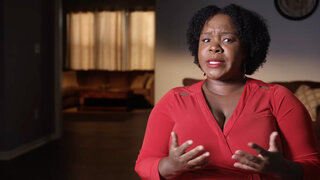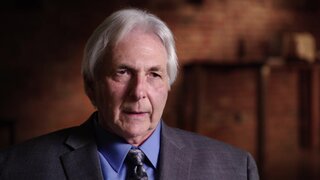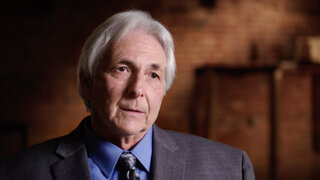Create a free profile to get unlimited access to exclusive videos, breaking news, sweepstakes, and more!
2 Husbands, 1 Lover Shot Dead: Inside A 'Black Widow Murders' Case
Multiple men in Josephine Gray’s life died in untimely, violent ways.
Over the span of 22 years, three men ended up shot to death in Baltimore after getting involved with the same woman: Josephine Gray, a seemingly unassuming school custodian and church-goer, according to “Black Widow Murders,” airing Sundays at 7/6c on Oxygen.
In June 1996, the body of 28-year-old Clarence Goode was found in a car by police responding to a report of an abandoned vehicle in a rough part of the city.
“He was shot in the chest and back,” Joe Mudano, a Montgomery County police detective, told producers. “He had a bag of cocaine inside of his underwear, which was kind of bizarre.”
The scene looked like it had been staged to make it appear that Clarence’s death was a drug deal gone wrong.
Police learned that Clarence had moved from Brooklyn to Baltimore in the early 1980s as a teenager when he showed signs of going down a bad path. His mother sent him to live with his then-35-year-old cousin, Josephine Gray.
At the time she and her husband, William “Robert” Gray, were raising their children, most of whom were adults. But as Clarence’s life steadily improved in his new surroundings, the Gray marriage deteriorated.
Robert moved out, while Clarence stayed with Josephine. After her marriage ended, she began seeing Andre Savoy, a fellow school custodian. Clarence, meanwhile, eventually began dating a woman with whom he had a child. His life was in a good place, according to investigators. And then it was cut short by two bullets.
When detectives looked into the homicide they learned from witnesses that Clarence and Josephine were having a sexual relationship. Their affair was why Robert moved out, according to "Black Widow Murders."
Between the age difference and the power dynamics of the cousins’ relationship, Josephine dominated Clarence, according to Dr. Katherine Ramsland, a forensic psychologist.
Even after Andre moved in with Josephine, her relationship with Clarence continued for a time, according to “Black Widow Murders.” Andre knew about the situation and was content to stay. Clarence ended up moving out but couldn’t fully break away from Josephine.
Although investigators didn’t consider Andre a suspect in Clarence’s slaying, Josephine was another story.
Police learned that other men in her life had untimely, violent deaths.
"The Baltimore police were only looking at the very tip of the iceberg when they first found Clarence,” said former State and Federal Prosecutor Jim Trusty.
At that time Josephine had been previously married to Norman Stribbling for a decade. They had five children. But the marriage had also curdled by the mid-’70s.
According to investigators featured in the program, the union crumbled for a couple of reasons. One of them was because Josephine was having an affair with Robert Gray. The other was that Norman feared for his life.
Norman had told friends that he had woken up in bed and found Josephine pointing a gun at him. About a month later, he was found shot to death in his car, according to "Black Widow Murders."
Josephine was identified as being “definitely involved” in Norman’s slaying, said Mudano.
Investigators alleged that Josephine and Robert had offered two of her relatives $10,000 to kill Norman. Authorities charged Josephine and Robert with solicitation of a murder. The case never went to trial because the key witnesses had “dropped off the face of the earth,” said Trusty. The charges were ultimately dropped.
Josephine and Robert married. She used the $16,000 life insurance payout from Norman's death as a down payment on a house, according to "Black Widow Murders."
After 15 years, cracks in the Gray marriage began to widen and worsen. That was exacerbated by Josephine’s relationship with Clarence, according to "Black Widow Murders."
Like Norman, investigators alleged that Robert came to fear Josephine. Robert eventually reported to authorities that Josephine threatened him with a knife and Clarence threatened him with a gun. Robert pressed charges against them.
In November 1990, a week before he was scheduled to testify, Robert was found shot to death in his home. There was no forced entry, so whoever went in had a key, said Mudano.
Josephine was charged in the case. But due to a lack of evidence, charges against her were dropped.
She collected a $50,000 life insurance policy payout on Robert, which, investigators claimed, he didn’t even know existed.
In time Josephine, who’d gotten involved with Andre, grew restless with Clarence. According to investigators, Josephine had a $100,000 life insurance policy on Clarence.
Once again, investigators lacked evidence to build a strong murder case against Josephine.
They scrutinized the facts. Between 1974 and 1996, three of Josephine’s romantic partners met untimely ends. Investigations revealed that she stood to gain from each of their deaths.
They seized upon the slayer rule, which says that a killer can’t collect insurance if they participated in the murderous event. The use of phones and the U.S. mail for criminal purposes is mail and wire fraud. Josephine used the U.S. mail system to request claims.
Prosecutors had to prove Josephine’s complicity in each of the murders as well as her direct involvement in collecting insurance proceeds from these deaths. In January 2002 Josephine Gray was charged with eight counts of wire and mail fraud.
Prosecutors painted Josephine as “this black widow who killed all three of her lovers for life insurance and monetary gain,” according to true crime author and podcaster Tia L. Lincoln.
“The prosecutors argued basically that Josephine used Robert to kill Norman,” said Lincoln. “Then she used Clarence to kill Robert.”
As described in "Black Widow Murders," at trial, Josephine's attorneys reminded the jury that three police investigations failed to prove she had anything to do with the killings.
In December 2002, however, she was found guilty on five counts of mail fraud and three counts of wire fraud, according to court documents. Each count carried a five-year sentence.
Josephine Gray, now 76, is serving her time in a federal medical detention center in Texas.
To learn more about the case, watch “Black Widow Murders,” airing Sundays at 7/6c on Oxygen.























